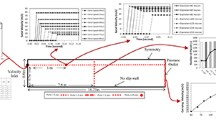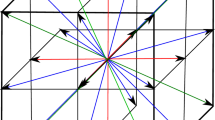Abstract
The wind erosion is the main cause of many environmental phenomena such as desertification, dust haze, sandstorms, and energy balance changes in the atmosphere. Wind erosion occurs when the friction velocity exceeds the threshold friction velocity. Threshold friction velocity depends on many parameters such as surface roughness, heat flux, moisture of soil and soil texture. In this article, the horizontal and vertical fluxes of particles due to wind erosion have been studied using a numerical method. Atmospheric boundary layer has been modeled with computational fluid dynamic for different wind profiles and the flow field near the surface has been solved. The values of velocity’s components of air flow have been used to calculate wind erosion fluxes according to balance equations of particles. The erosion flux of particles in terms of suspension, saltation and creeping have been calculated according to threshold friction velocities. Finally, the relation between fluxes has been determined and the correlation of erosion flux and direct suspension in terms of friction velocity and particle diameter has been presented. Comparing the results with previous works revealed that the value of direct suspension of particle C (kg/ms) is related to total erosion flux Q (kg/ms) as Q = 30,553 C 2 + 6.4316 C + 0.0017.








Similar content being viewed by others
References
Afrasiab P, Delbari M (2013) Assessing the risk of soil vulnerability to wind erosion through conditional simulation of soil water content in Sistan plain, Iran. Environ Earth Sci 70:2895–2905
Bagnold RA (1941) The physics of blown sand and desert dunes. Methuen, New York
Belly PY (1964) Sand movement by wind. United States Army Coast Engineering Research Center, Technical Memorandum I. pp 1–38
Bird RB, Stewart W, Lightfoot E (2002) Transport phenomena. John Wiley & Sons, New York
Blocken B, Stathopoulos T, Carmeliet J (2007) CFD simulation of the atmospheric boundary layer: wall function problems. Atmos Environ 41(2):238–252
Bretherton FP (1962) The motion of rigid particles in a shear flow at low Reynolds numbers. J Fluid Mech 14:284–304
Burton T, Sharpe D, Jenkins N, Bossanyi E (2001) Wind energy handbook. Wiley, London, UK
Chepil WS (1945) Dynamics of wind erosion. Soil Sci 60:305–320
Chepil WS (1951) Properties of soil which influence wind erosion. Soil Sci 72:387–401
Chepil WS (1956) Influence of moisture on erodibility of soil by wind. Soil Sci 20:288–292
Chepil WS (1985) Soil conditions that influence wind erosion. US Department of Agriculture, Agriculture Research Service, Technical Bulletin No. 1185. Washington, DC
Chepil WS, Woodruff NP (1963) The physics of wind erosion and its control. Adv Agron 15:211–302
Edlefson NE, Anderson ABC (1943) Thermodynamics of soil moisture. Hilgardia 15:31–298
Fe´can F, Marticorena B, Bergametti G (1999) Parameterization of the increase of the Aeolian erosion threshold wind friction velocity due to soil moisture for arid and semiarid areas. Ann Geophys 17:149–157
FLUENT Inc (2006) FLUENT 6.3 user’s guide
Gabriels D, Cornelis WM, Pollet I (1997) The ICE wind tunnel for wind and water erosion studies. Soil Technol 10:1–8
Gillette DA (1979) Environmental factors affecting dust emission by wind erosion. In: Morales J (ed) In Saharan Dust. Wiley, New York, pp 71–94
Greeley R, Iversen JD (1985) Wind as a geological process on Earth, Mars, Venus and Titan. Cambridge University Press, New york
Hagen LJ (1984) Soil aggregate abrasion by impacting sand and soil particles. Trans ASAE 27(3):805–808
Hagen LJ (1991) Wind erosion mechanics: abrasion of aggregated soil. Am Soc Agric Eng 34(4):831–837
Hagen LJ (1999) Assessment of wind erosion parameters using wind tunnels. In: Stott DE, Mohtar RH, Steinhardt GC (eds) Sustaining the Global Farm. Proceedings of 10th International Soil Conservation Organization Conference, Purdue University, West Lafayette, IN, 24–29 May, pp 742–746
Hargreaves DM, Wright NG (2007) On the use of the k-epsilon model in commercial CFD software to model the neutral atmospheric boundary layer. J Wind Eng Ind Aerodyn 95(5):355–369
Hotta K, Takeda K, Iinoya K (1974) The capillary binding force of a liquid bridge. Powder Technol 10:231–242
Hunt JCR, Weber AH (1979) A Lagrangian statistical analysis of diffusion from a ground-level source in a turbulent boundary layer. Quart J Roy Meteor Soc 105:423–443
Iversen JD, White BR (1982) Saltation threshold on earth, mars and venus. Sedimentology 29:111–119
Iversen JD, Pollack JB, Greeley R et al (1976) Saltation threshold on mars: the effect on interparticle force, surface roughness, and low atmospheric density. Icarus 29:381–393
Jacobson MZ (2005) Fundamentals of atmospheric modeling, 2nd edn. Cambridge University Press, New York
Kawamura R (1964) Study of sand movement by wind. In: Hydraulic engineering laboratory. Technical report, University of California, Berkeley, CA HEL-2-8, pp 99–108
Kawata Y, Tsuchiya Y (1976) Influence of water content on the threshold of sand movement and the rate of sand transport in blown sand. Proc Jpn Soc Civ Eng 249(19):005–100
Launder BE, Spalding DB (1974) The numerical computation of turbulent flows. Comp Methods Appl Mech Eng 3:269–289
Lettau K, Lettau HH (1978) Experimental and micrometeorological field studies of dune migration. Exploring the world’s driest climate. University of Wisconsin, Madison, pp 110–147
Liu S, Wang T (2014) Aeolian processes and landscape change under human disturbances on the Sonid grassland of inner Mongolian Plateau, northern China. Environ Earth Sci 71:2399–2400
Lu H, Shao Y (2001) Toward quantitative prediction of dust storms: an integrated wind erosion modeling system and its applications. Environ Model Softw 16:233–249
Marticorena B, Bergametti G (1995) Modeling the atmospheric dust cycle: part 1. Design of a soil-derived dust emission scheme. J Geophys Res 100:16415–16430
Marticorena B, Bergametti G et al (1997) Modeling the atmospheric dust cycle: part 2. Simulation of Saharan dust sources. J Geophys Res 102D(40):4387–4404
McKenna-Neuman C, Gilbert R (1986) Aeolian processes and landforms in glaciofluvial environments of southeastern Baffin Island, NWT, Canada. In: Nickling WG (ed) Aeolian Geomorphology. Allen & Unwin, Boston, pp 213–235
McKenna-Neumann C, Nickling WG (1989) A theoretical and wind tunnel investigation of the effect of capillary water on the entrainment of sediment by wind. Can J Soil Sci 69:79–96
Mirzamostafa N, Hogen LJ, Stone LR, Skidmore EL (1998) Soil aggregate and texture effects on suspension components from wind erosion. SSSA J 62(5):1351–1361
Morrison F (2013) Data correlation for friction factor in smooth pipes. Michigan Technological University, Houghton
Musick HB, Gillette DA (1990) Field evaluation of relationships between a vegetation structural parameter and sheltering against wind erosion. Land Degrad Rehabil 2:87–94
Namikas SL, Sherman DJ (1995) A review of the effects of surface moisture content on aeolian sand transport. In: Tchakerian VP (ed) Desert Aeolian Processes. Chapman & Hall, London, pp 269–293
Nickling WG (1984) The stabilizing role of bonding agents on the entrainment of sediment by wind. Sedimentology 31:111–117
Nickling WG, Ecclestone M (1981) The effects of soluble salts on the threshold shear velocity of fine sand. Sedimentology 28:505–510
Owen RP (1964) Saltation of uniform grains in air. J Fluid Mech 20:225–242
Pietsch W (1968) Tensile strength of granular materials. Nature 217:736–737
Saffman G (1965) The lift on a small sphere in a slow shear flow. J Fluid Mech 22:385–400
Saleh A, Fryrear DW (1995) Threshold wind velocities of wet soils as affected by windblown sand. Soil Sci 160:304–309
Schlichting H (1955) Boundary layer theory. McGraw-Hill, New York
Shao Y (2000) Physics and modeling of wind erosion. Kluwer Academic Publishers, USA
Shao Y, Leslie LM (1997) Wind erosion prediction over Australian continent. J Geophys Res 102:30091–30105
Shao Y, Li A (1999) Numerical modeling of saltation in atmospheric surface layer. Bound Layer Meteorol 91:199–225
Shao Y, Raupach MR, Leys JF (1996) A model for predicting Aeolian sand drift and dust entrainment on scales from paddock to region. Aust J Soil Res 34:309–342
Skidmore EL (1986) Wind erosion climatic erosivity. Clim Change 9:195–208
Torsten G, Ugur T (2003) Modelling and measuring of cohesion in wet granular materials. Powder Technol 133:203–215
Webb NP, McGowan HA, Phinn SR et al (2006) AUSLEM (Australian Land Erodibility Model): a tool for identifying wind erosion hazard in Australia. Geomorphology 78(3–4):179–200
Zdunkowski W, Bott A (2003) Dynamics of the atmosphere: a course in theoretical meteorology. Cambridge University Press, New York
Zhang X (2009) CFD simulation of neutral ABL flows. Dissertation, Technical University of Denmark
Zhang H, Ahmadi G (2000) Aerosol particle transport and deposition in vertical and horizontal turbulent duct flows. J Fluid Mech 406:55–80
Zhang Z, Dong Z, Chen S (2013) Wind erodibility in eastern Ningxia Province, China. Environ Earth Sci 68:2263–2270
Zingg AW (1953) Wind-tunnel studies of the movement of sedimentary material. In: Proceedings of the 5th hydraulic conference, vol 34. University of Iowa Studies in Engineering, Iowa City, IA, pp 111–135
Author information
Authors and Affiliations
Corresponding author
Rights and permissions
About this article
Cite this article
Ashrafi, K., Kalhor, M., Shafie-Pour, M. et al. Numerical simulation of aerodynamic suspension of particles during wind erosion. Environ Earth Sci 74, 1569–1578 (2015). https://doi.org/10.1007/s12665-015-4153-9
Received:
Accepted:
Published:
Issue Date:
DOI: https://doi.org/10.1007/s12665-015-4153-9




